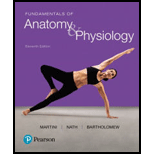
Pearson eText Fundamentals of Anatomy & Physiology -- Instant Access (Pearson+)
11th Edition
ISBN: 9780136874089
Author: Frederic Martini, Judi Nath
Publisher: PEARSON+
expand_more
expand_more
format_list_bulleted
Concept explainers
Question
Chapter 18, Problem 33CP
Summary Introduction
To discuss:
The functional relationship between the endocrine system and the muscular system.
Introduction:
Endocrine system is a system includes chemical messengers also called hormones that regulate the human activities. These products of endocrine system controls and coordinates the body processes along with the nervous system. The muscular system of the body includes all over the muscles of the body which coordinates in the body movements.
Expert Solution & Answer
Want to see the full answer?
Check out a sample textbook solution
Students have asked these similar questions
Give only the mode of inheritance consistent with all three pedigrees and only two reasons that support this, nothing more, (it shouldn't take too long)
O
Describe the principle of homeostasis.
Chapter 18 Solutions
Pearson eText Fundamentals of Anatomy & Physiology -- Instant Access (Pearson+)
Ch. 18 - Prob. 1CPCh. 18 - Describe paracrine communication.Ch. 18 - Identify five mechanisms of intercellular...Ch. 18 - What primary factor determines each cells hormonal...Ch. 18 - Prob. 5CPCh. 18 - Prob. 6CPCh. 18 - Prob. 7CPCh. 18 - If a person were dehydrated, how would the amount...Ch. 18 - Prob. 9CPCh. 18 - Prob. 10CP
Ch. 18 - Prob. 11CPCh. 18 - Prob. 12CPCh. 18 - When a persons thyroid gland is removed, signs of...Ch. 18 - Prob. 14CPCh. 18 - Prob. 15CPCh. 18 - Prob. 16CPCh. 18 - Prob. 17CPCh. 18 - Prob. 18CPCh. 18 - Prob. 19CPCh. 18 - Prob. 20CPCh. 18 - Increased amounts of light would inhibit the...Ch. 18 - Prob. 22CPCh. 18 - Prob. 23CPCh. 18 - Prob. 24CPCh. 18 - Prob. 25CPCh. 18 - Prob. 26CPCh. 18 - Prob. 27CPCh. 18 - Prob. 28CPCh. 18 - Prob. 29CPCh. 18 - The lack of which hormones would inhibit skeletal...Ch. 18 - Prob. 31CPCh. 18 - Prob. 32CPCh. 18 - Prob. 33CPCh. 18 - Prob. 1RQCh. 18 - Prob. 2RQCh. 18 - Prob. 3RQCh. 18 - Prob. 4RQCh. 18 - The two hormones released by the posterior lobe of...Ch. 18 - Prob. 6RQCh. 18 - Prob. 7RQCh. 18 - Prob. 8RQCh. 18 - Prob. 9RQCh. 18 - Prob. 10RQCh. 18 - Prob. 11RQCh. 18 - Prob. 12RQCh. 18 - Prob. 13RQCh. 18 - Prob. 14RQCh. 18 - Prob. 15RQCh. 18 - Prob. 16RQCh. 18 - Prob. 17RQCh. 18 - What is the primary difference in the way the...Ch. 18 - Prob. 19RQCh. 18 - Prob. 20RQCh. 18 - Prob. 21RQCh. 18 - Prob. 22RQCh. 18 - Prob. 23RQCh. 18 - Prob. 24RQCh. 18 - Prob. 25RQCh. 18 - Prob. 26RQCh. 18 - Prob. 27RQCh. 18 - Prob. 28RQCh. 18 - Prob. 29RQCh. 18 - Prob. 1CCCh. 18 - Prob. 2CC
Knowledge Booster
Learn more about
Need a deep-dive on the concept behind this application? Look no further. Learn more about this topic, biology and related others by exploring similar questions and additional content below.Similar questions
- Explain how the hormones of the glands listed below travel around the body to target organs and tissues : Pituitary gland Hypothalamus Thyroid Parathyroid Adrenal Pineal Pancreas(islets of langerhans) Gonads (testes and ovaries) Placentaarrow_forwardWhat are the functions of the hormones produced in the glands listed below: Pituitary gland Hypothalamus Thyroid Parathyroid Adrenal Pineal Pancreas(islets of langerhans) Gonads (testes and ovaries) Placentaarrow_forwardDescribe the hormones produced in the glands listed below: Pituitary gland Hypothalamus Thyroid Parathyroid Adrenal Pineal Pancreas(islets of langerhans) Gonads (testes and ovaries) Placentaarrow_forward
- Please help me calculate drug dosage from the following information: Patient weight: 35 pounds, so 15.9 kilograms (got this by dividing 35 pounds by 2.2 kilograms) Drug dose: 0.05mg/kg Drug concentration: 2mg/mLarrow_forwardA 25-year-old woman presents to the emergency department with a 2-day history of fever, chills, severe headache, and confusion. She recently returned from a trip to sub-Saharan Africa, where she did not take malaria prophylaxis. On examination, she is febrile (39.8°C/103.6°F) and hypotensive. Laboratory studies reveal hemoglobin of 8.0 g/dL, platelet count of 50,000/μL, and evidence of hemoglobinuria. A peripheral blood smear shows ring forms and banana-shaped gametocytes. Which of the following Plasmodium species is most likely responsible for her severe symptoms? A. Plasmodium vivax B. Plasmodium ovale C. Plasmodium malariae D. Plasmodium falciparumarrow_forwardStandard Concentration (caffeine) mg/L Absorbance Reading 10 0.322 20 0.697 40 1.535 60 2.520 80 3.100arrow_forward
- please draw in the answers, thank youarrow_forwarda. On this first grid, assume that the DNA and RNA templates are read left to right. DNA DNA mRNA codon tRNA anticodon polypeptide _strand strand C с A T G A U G C A TRP b. Now do this AGAIN assuming that the DNA and RNA templates are read right to left. DNA DNA strand strand C mRNA codon tRNA anticodon polypeptide 0 A T G A U G с A TRParrow_forwardplease answer all question below with the following answer choice, thank you!arrow_forward
arrow_back_ios
SEE MORE QUESTIONS
arrow_forward_ios
Recommended textbooks for you
 Human Physiology: From Cells to Systems (MindTap ...BiologyISBN:9781285866932Author:Lauralee SherwoodPublisher:Cengage Learning
Human Physiology: From Cells to Systems (MindTap ...BiologyISBN:9781285866932Author:Lauralee SherwoodPublisher:Cengage Learning- Lifetime Physical Fitness & WellnessHealth & NutritionISBN:9781337677509Author:HOEGERPublisher:Cengage

Human Physiology: From Cells to Systems (MindTap ...
Biology
ISBN:9781285866932
Author:Lauralee Sherwood
Publisher:Cengage Learning



Lifetime Physical Fitness & Wellness
Health & Nutrition
ISBN:9781337677509
Author:HOEGER
Publisher:Cengage

